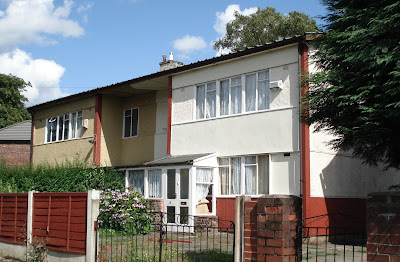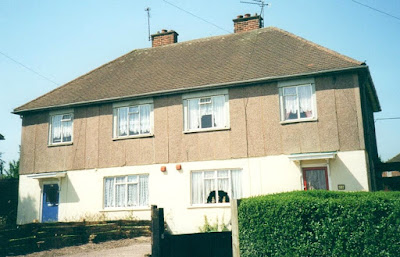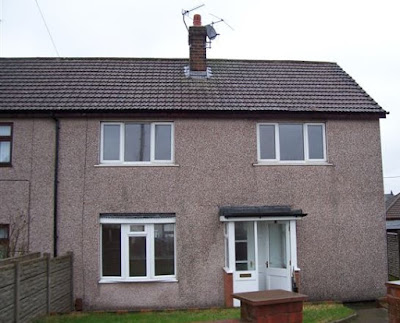Monday 11 June 2018
Crosswall Construction
The term ‘Crosswall’ relates to dwellings with brick party or gable end walls and timber frame front and rear elevations. They are often constructed on reinforced concrete raft type foundations. Roof structures are traditional timber beams and covered with tiles. The timber frame sections are often very thin. The front walls of the centre and right hand houses in the photograph below are partly clad with timber and part metal sheeting. Some may be clad with asbestos cement panels.
Many people may regard Crosswall construction as traditional, but it is fundamentally different to truly traditionally constructed houses, therefore is included in this series of blog posts about non-traditional construction.
Note that the front elevation of the property to left of the photograph has been modified. The brick and tile face and different window positions suggest the wall has been rebuilt in masonry.
Houses of Crosswall construction do not usually pose any significant problems for mortgage lending, but it is important that the external faces of the front and rear elevations are well maintained to reduce the risk of timber decay.
Sunday 10 June 2018
Howard Houses
Howard houses are a form of metal frame construction with exposed columns to the corners and thin concrete panel walls. They also have metal beams internally. Roofs are of a shallow pitch and covered with metal sheets. Asbestos cement panels may also be present.
Saturday 9 June 2018
Dyke CCC Houses
This is another large panel system and designated defective. The storey height concrete panels are easily visible at first floor level. The ground floor walls are rendered. Roofs are of the hip style. Problems include cracking between panels and metal reinforcement corrosion.
Friday 8 June 2018
Unity Houses
These have storey height reinforced concrete columns linked at ceiling level by metal beams spanning front to rear. They are faced externally with concrete panels. Unity houses are also designated defective due to cracking of the panels and corrosion of metal fixings.
Thursday 7 June 2018
Gregory Houses
The pair of semi-detached houses in the photograph below look like Cornish Type I at first glance, but they do not have any visible columns and beams. Have not inspected these myself, but they are consistent in appearance with Gregory houses. This is another form on non-traditional concrete construction, also designated defective.
Wednesday 6 June 2018
No-fines Concrete Houses
Another form of non-traditional construction in residential dwellings is no-fines concrete. The most common type is probably Wimpey No-Fines. There is also Laing Easi-form which is similar. Both are so named after the developers who created them.
The walls are formed from concrete poured into a timber frame. Once set, the timber is removed, leaving the solid walls cast in situ. The concrete was of a special type with an aggregate of round pebbles and no fine particles, hence the name 'no-fines'. The design resisted damp penetration as rainwater simply dripped off the pebbles and was unable to pass through to the interior due to the absence of any finer particles.
From the outside they look like typical post war semi detached houses with rendered walls. A matching rendered concrete chimney stack can be an identifying feature, but not always. Some of them have brick bays on the front. For a definite identification you need to look at the inner face of the gable end wall in the roof space. There you will see the round pebbles, as described above and shown in the photo below.
Usually the Wimpey no-fines is accepted for mortgage purposes. I have heard that the Easiform ones can be more difficult to mortgage due to known defects, but there are none in my area, so not had experience of them. If you've had dealings with a Laing Easiform house, it would be great if you could comment below.
If you've been enjoying this week's articles on non-traditional houses, please 'like' my page at Hallworth House Survey Education and click on 'get notifcations'. Future ones should then go to your timeline.
Tuesday 5 June 2018
Schindler Houses
When does an unmortgageable house fool the surveyor into thinking it is mortgageable?
The photo below is of a Schindler House. These are another form of non-traditional construction, with a hidden frame, but brick external walls and a traditional roof. Like the Airey, Cornish and Wates houses shown in earlier posts, they were designated defective and cannot be mortgaged.
The problem is that the frame is well hidden and they appear to be traditional brick structures from the outside and from within the roof space. Worse still, estates where they are located often also contain traditionally built counterparts side by side. They all look the same. There is a risk that the unwary surveyor will not recognise a Schindler house from a traditional house.
In the photo, the house on the left has re-built walls, indicating that it has been subject to a repair scheme. The house to the right has its original walls in situ. However, there are alternative repair schemes for this type of dwelling which can be performed from the inside, allowing the original walls to remain. Therefore it is possible that the right hand house has also been repaired.
If you enter a local authority estate where some of the houses have rebuilt walls, it is a sign that Schindler Houses may be present.
I'm going to rest the subject of non-traditional construction for now and move onto something else. If you've enjoyed this six part series, 'like' my page at Hallworth House Survey Education and click 'get notifications' to receive future posts of this kind on your timeline.
Monday 4 June 2018
BISF Houses
Few non-traditionally constructed houses can be as easy to notice as these when in their original state. They are BISF houses. 'BISF' stands for British Iron and Steel Federation. When I was as a student of surveying houses a long time ago, I was told that 'BISF' stood for British Industrial Steel Frame, but have not heard that term since, so don't use it.
They were built in the early post war years when there was a shortage of traditional building materials. They have concrete walls at ground floor level and a metal frame above with metal panels bolted on. The roof structure is also a metal frame and is covered with metal sheets (or sometimes asbestos cement panels in the early days). The photo below was taken a long time ago and shows examples of the original metal windows.
Unlike the Airey, Cornish and Wates houses discussed in my earlier posts in this series, BISF houses are not designated defective in legislation and can be mortgaged, but obtaining a mortgage on one can be difficult as they are subject to limited lending criteria. Typically, this used to be 75% loan to value, which means that the buyer must stump up 25% of the purchase price in cash. Most are found on local authority estates. Consequently relatively few found themselves into private hands through the Right to Buy scheme. Market values are usually always less than a comparable traditionally built house however. From an investment point of view, you may get a good return, if you can get a mortgage on one.
One half of the pair of BISF semis shown above appears to have walls reconstructed in modern brickwork. Did not inspect this house myself, but suspect this is a brick cladding over the original metal frame. Unless all the houses on the estate are treated in this way, there is no way of disguising the history of the dwelling. Such works are unlikely to be cost effective. Many BISF houses have been clad with external insulation. This gives the houses a more modern and traditional appearance and improved thermal resistance of the walls.
I'll doing further posts on non-traditional housing, each briefly examining some of the most common types. All can be found on my Facebook Page - Hallworth House Survey Education. If you have an interest in this subject, are an investor or regular buyer of houses, keep in touch as I am sharing lots of information that you'll find interesting. If you look up the Page on Facebook, 'like' the page and click 'get notifications' from the menu, they should appear on your timeline. Enjoy reading.
Sunday 3 June 2018
Wates Houses
The house pictured in the photographs below is of large panel concrete construction, where the panels are the height of one full storey. This one is probably a Wates house. It was located on an estate of like dwellings, now demolished and redeveloped. They are still a common sight on some local authority estates.
There will be two more articles in this series, then I will move onto a new topic. To have my posts delivered to your timeline 'like' my FB page at Hallworth House Survey Education, then click 'get notifications'.
Saturday 2 June 2018
Cornish Houses
The upper photo below is of a 'Cornish House'. It has concrete panels at ground floor level and a timber frame covered with tiles to the first floor and roof. There is also a variant type Cornish house which has floor to roof level concrete panels. A row of these is shown in the lower photo. These are known as Cornish type II and the upper example is a Cornish type I.
Like with the Airey house shown yesterday, Cornish houses are designated defective and not mortgageable unless repaired through an approved scheme.
You'll notice that the left hand half of the semi in the top photo has been repaired, with modern brick walls visible in place of the concrete panels. The fact that the attached neighbour has not been repaired is usually still a mortgageability problem for the repaired house. Would be good to hear any experiences of this.
Friday 1 June 2018
Airey Houses
Following on from yesterdays post about Cussins Houses and the earlier one about BISF Houses, in this artical I'm talking about a different type of non-traditionally constructed dwelling - The Airey House. Both BISF and Cussins houses can be mortgaged, but Airey Houses in their original state cannot.
Most of them have gone now, but used to be a common sight, often in small cul-de-sacs in village locations. They are built from reinforced concrete columns, with an external leaf of concrete panels and plasterboard dry lining on the inside. Note the tile clad top to the gable end. This is a common feature of many types of non-traditional construction.
The problem was that the concrete columns were too thin, allowing moisture to penetrate, leading to corrosion of the metal reinforcement. They were designated defective in legislation and are not mortgageable on any terms.
There were (and may still be) approved repair schemes, usually involving removal of the concrete components and replacement with modern cavity brick and blockwork, as can be seen on the next photo. You may notice a difference in colour of the brickwork, indicating that the reconstruction of each semi was done at different times. Once repaired in this way, the houses should be mortgageable, provided all the necessary documentation is in place.
My other posts on building defect related matters can be found on my Facebook Page at Hallworth House Survey Education. 'Like' the page and click 'get notifications' to receive future posts on your timeline.
Subscribe to:
Posts (Atom)
Crosswall Construction
The term ‘Crosswall’ relates to dwellings with brick party or gable end walls and timber frame front and rear elevations. They are often con...
-
The term ‘Crosswall’ relates to dwellings with brick party or gable end walls and timber frame front and rear elevations. They are often con...
-
Another form of non-traditional construction in residential dwellings is no-fines concrete. The most common type is probably Wimpey No-Fines...
-
When does an unmortgageable house fool the surveyor into thinking it is mortgageable? The photo below is of a Schindler House. These are a...















